Analysis of Recruitment, Leadership, and Teamwork at PM Courier
VerifiedAdded on 2019/12/03
|14
|4250
|137
Report
AI Summary
This report analyzes the recruitment, leadership, and teamwork strategies implemented at PM Courier. The introduction highlights the challenges faced by the company, including employee attrition and customer dissatisfaction, due to ineffective recruitment and poor leadership. Task 1 focuses on the importance of recruitment and selection, detailing necessary documents, legal considerations, and the selection process. Task 2 examines leadership skills, differentiating between leadership and management, comparing various leadership styles, and exploring methods to motivate staff. Task 3 assesses the benefits of team working within the organization, and Task 4 focuses on planning, monitoring, and assessing employee performance. The report concludes by summarizing the key findings and recommendations for improving PM Courier's operational efficiency through better human resource management and leadership practices.
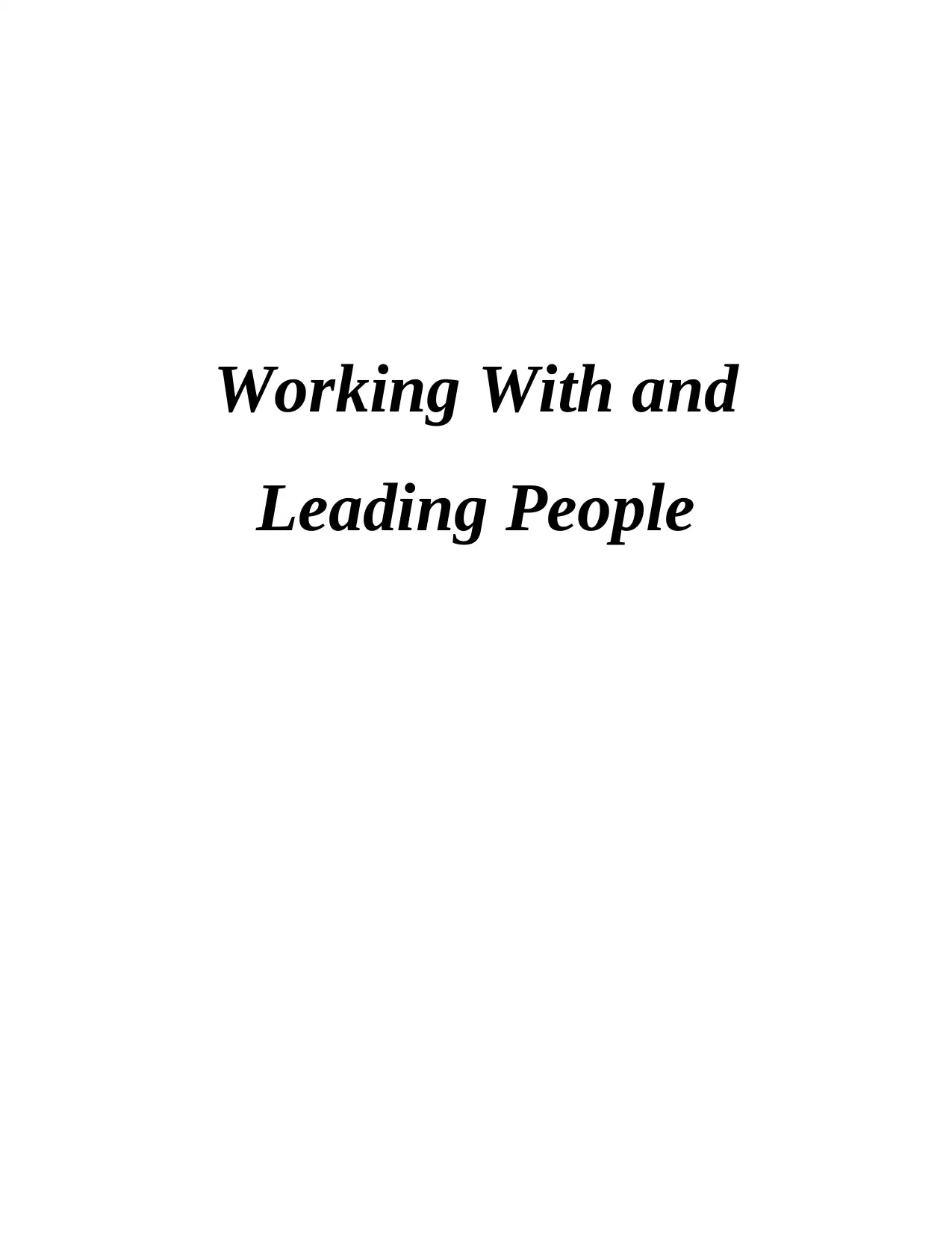
Working With and
Leading People
Leading People
Paraphrase This Document
Need a fresh take? Get an instant paraphrase of this document with our AI Paraphraser
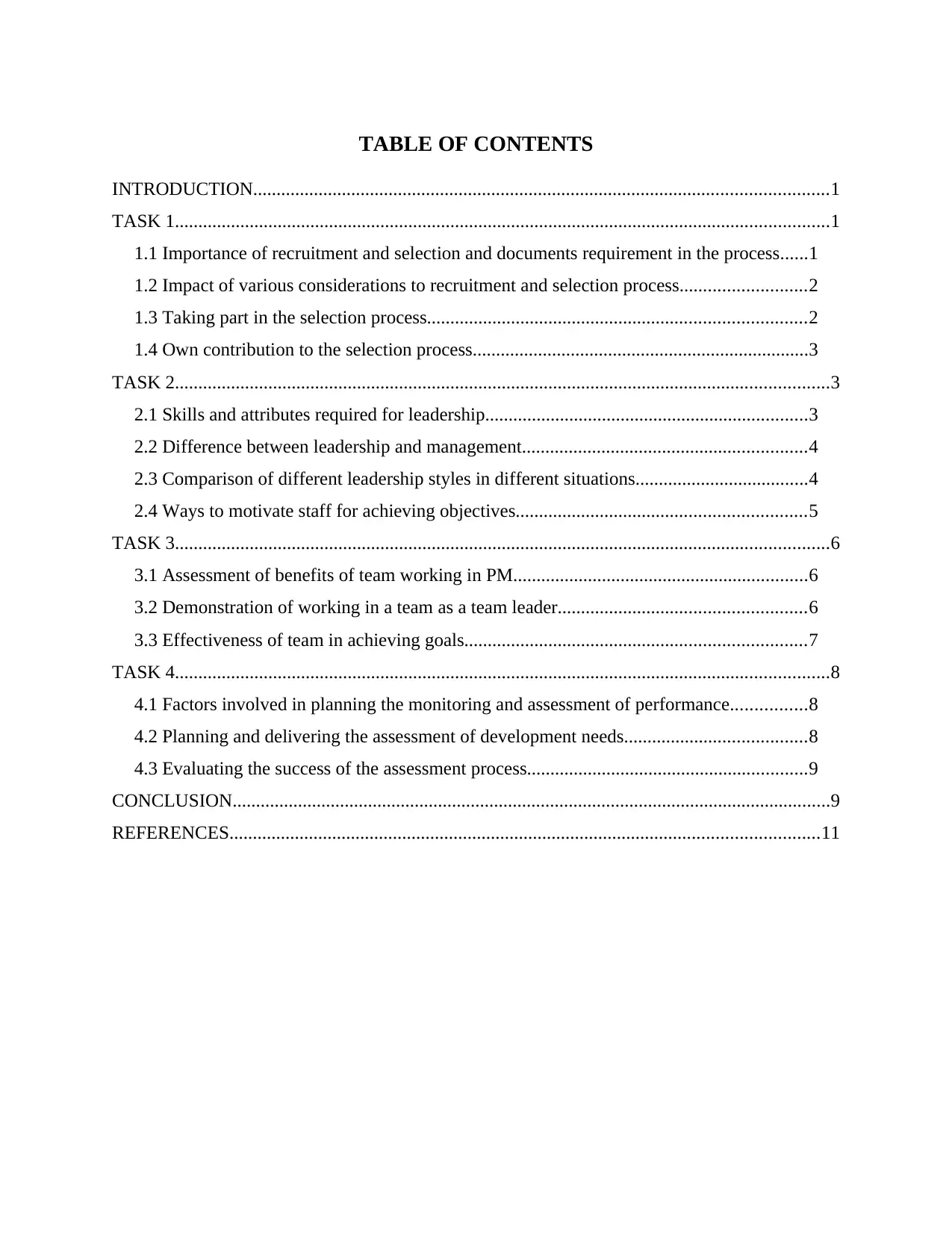
TABLE OF CONTENTS
INTRODUCTION...........................................................................................................................1
TASK 1............................................................................................................................................1
1.1 Importance of recruitment and selection and documents requirement in the process......1
1.2 Impact of various considerations to recruitment and selection process...........................2
1.3 Taking part in the selection process.................................................................................2
1.4 Own contribution to the selection process........................................................................3
TASK 2............................................................................................................................................3
2.1 Skills and attributes required for leadership.....................................................................3
2.2 Difference between leadership and management.............................................................4
2.3 Comparison of different leadership styles in different situations.....................................4
2.4 Ways to motivate staff for achieving objectives..............................................................5
TASK 3............................................................................................................................................6
3.1 Assessment of benefits of team working in PM...............................................................6
3.2 Demonstration of working in a team as a team leader.....................................................6
3.3 Effectiveness of team in achieving goals.........................................................................7
TASK 4............................................................................................................................................8
4.1 Factors involved in planning the monitoring and assessment of performance................8
4.2 Planning and delivering the assessment of development needs.......................................8
4.3 Evaluating the success of the assessment process............................................................9
CONCLUSION................................................................................................................................9
REFERENCES..............................................................................................................................11
INTRODUCTION...........................................................................................................................1
TASK 1............................................................................................................................................1
1.1 Importance of recruitment and selection and documents requirement in the process......1
1.2 Impact of various considerations to recruitment and selection process...........................2
1.3 Taking part in the selection process.................................................................................2
1.4 Own contribution to the selection process........................................................................3
TASK 2............................................................................................................................................3
2.1 Skills and attributes required for leadership.....................................................................3
2.2 Difference between leadership and management.............................................................4
2.3 Comparison of different leadership styles in different situations.....................................4
2.4 Ways to motivate staff for achieving objectives..............................................................5
TASK 3............................................................................................................................................6
3.1 Assessment of benefits of team working in PM...............................................................6
3.2 Demonstration of working in a team as a team leader.....................................................6
3.3 Effectiveness of team in achieving goals.........................................................................7
TASK 4............................................................................................................................................8
4.1 Factors involved in planning the monitoring and assessment of performance................8
4.2 Planning and delivering the assessment of development needs.......................................8
4.3 Evaluating the success of the assessment process............................................................9
CONCLUSION................................................................................................................................9
REFERENCES..............................................................................................................................11
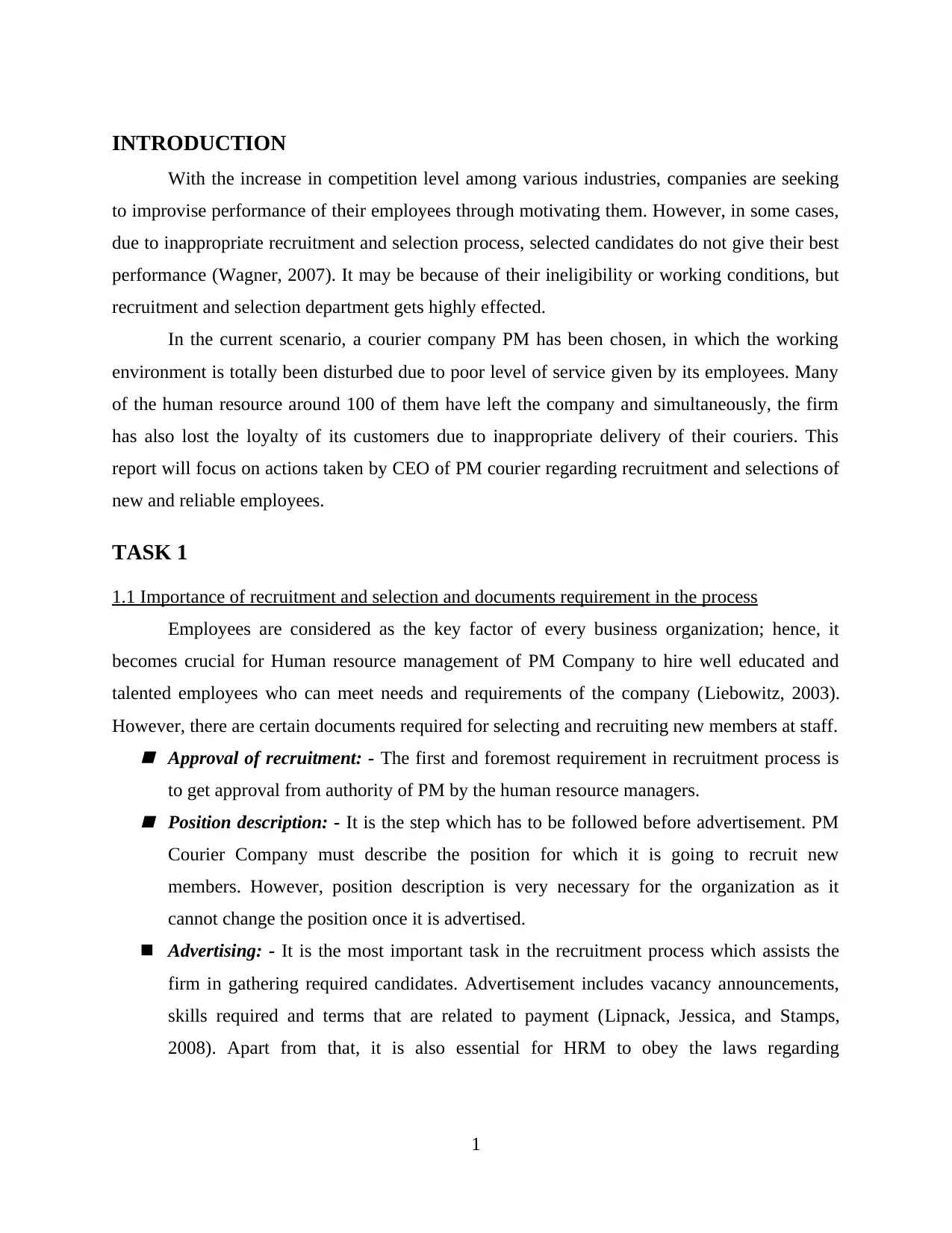
INTRODUCTION
With the increase in competition level among various industries, companies are seeking
to improvise performance of their employees through motivating them. However, in some cases,
due to inappropriate recruitment and selection process, selected candidates do not give their best
performance (Wagner, 2007). It may be because of their ineligibility or working conditions, but
recruitment and selection department gets highly effected.
In the current scenario, a courier company PM has been chosen, in which the working
environment is totally been disturbed due to poor level of service given by its employees. Many
of the human resource around 100 of them have left the company and simultaneously, the firm
has also lost the loyalty of its customers due to inappropriate delivery of their couriers. This
report will focus on actions taken by CEO of PM courier regarding recruitment and selections of
new and reliable employees.
TASK 1
1.1 Importance of recruitment and selection and documents requirement in the process
Employees are considered as the key factor of every business organization; hence, it
becomes crucial for Human resource management of PM Company to hire well educated and
talented employees who can meet needs and requirements of the company (Liebowitz, 2003).
However, there are certain documents required for selecting and recruiting new members at staff. Approval of recruitment: - The first and foremost requirement in recruitment process is
to get approval from authority of PM by the human resource managers. Position description: - It is the step which has to be followed before advertisement. PM
Courier Company must describe the position for which it is going to recruit new
members. However, position description is very necessary for the organization as it
cannot change the position once it is advertised.
Advertising: - It is the most important task in the recruitment process which assists the
firm in gathering required candidates. Advertisement includes vacancy announcements,
skills required and terms that are related to payment (Lipnack, Jessica, and Stamps,
2008). Apart from that, it is also essential for HRM to obey the laws regarding
1
With the increase in competition level among various industries, companies are seeking
to improvise performance of their employees through motivating them. However, in some cases,
due to inappropriate recruitment and selection process, selected candidates do not give their best
performance (Wagner, 2007). It may be because of their ineligibility or working conditions, but
recruitment and selection department gets highly effected.
In the current scenario, a courier company PM has been chosen, in which the working
environment is totally been disturbed due to poor level of service given by its employees. Many
of the human resource around 100 of them have left the company and simultaneously, the firm
has also lost the loyalty of its customers due to inappropriate delivery of their couriers. This
report will focus on actions taken by CEO of PM courier regarding recruitment and selections of
new and reliable employees.
TASK 1
1.1 Importance of recruitment and selection and documents requirement in the process
Employees are considered as the key factor of every business organization; hence, it
becomes crucial for Human resource management of PM Company to hire well educated and
talented employees who can meet needs and requirements of the company (Liebowitz, 2003).
However, there are certain documents required for selecting and recruiting new members at staff. Approval of recruitment: - The first and foremost requirement in recruitment process is
to get approval from authority of PM by the human resource managers. Position description: - It is the step which has to be followed before advertisement. PM
Courier Company must describe the position for which it is going to recruit new
members. However, position description is very necessary for the organization as it
cannot change the position once it is advertised.
Advertising: - It is the most important task in the recruitment process which assists the
firm in gathering required candidates. Advertisement includes vacancy announcements,
skills required and terms that are related to payment (Lipnack, Jessica, and Stamps,
2008). Apart from that, it is also essential for HRM to obey the laws regarding
1
⊘ This is a preview!⊘
Do you want full access?
Subscribe today to unlock all pages.

Trusted by 1+ million students worldwide
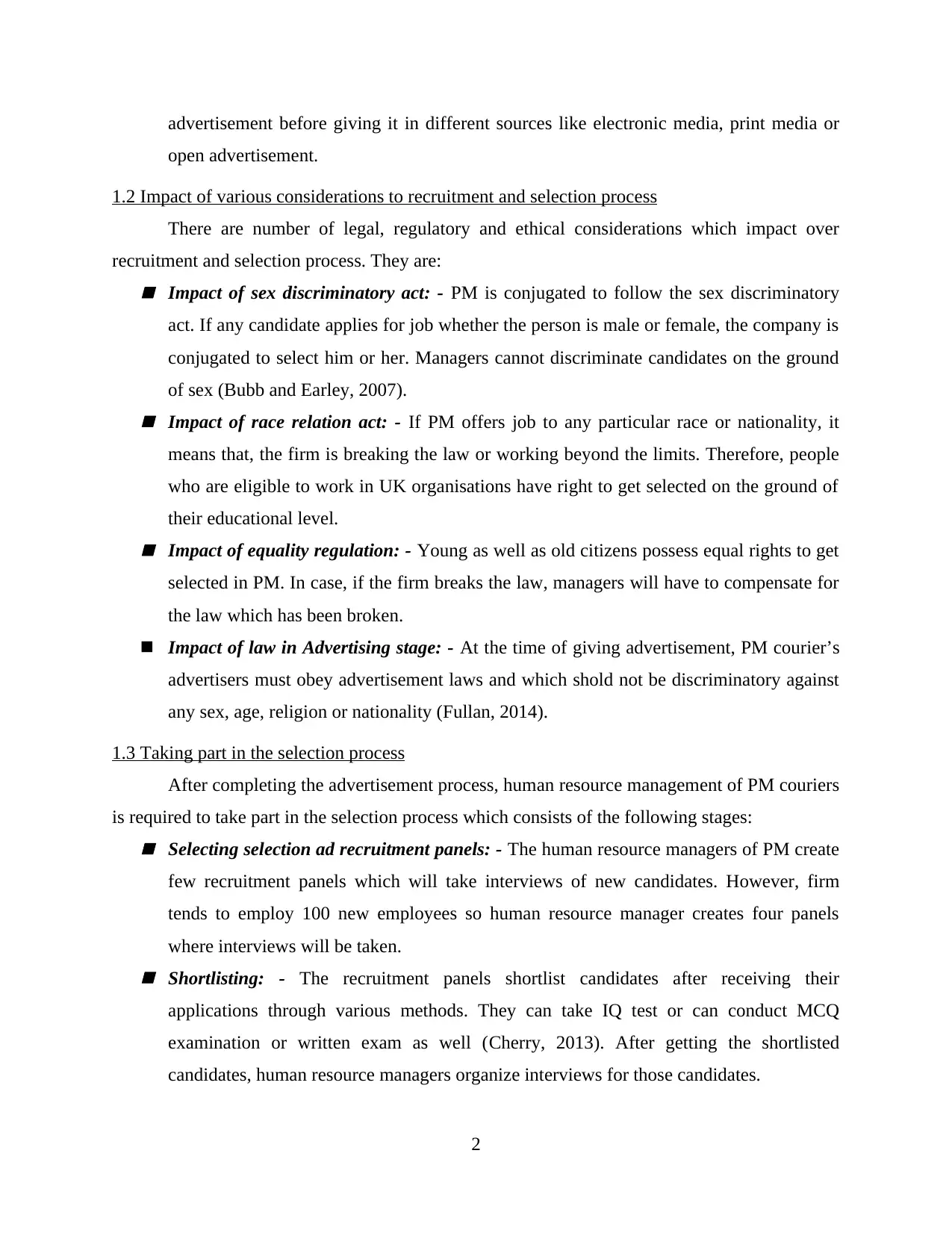
advertisement before giving it in different sources like electronic media, print media or
open advertisement.
1.2 Impact of various considerations to recruitment and selection process
There are number of legal, regulatory and ethical considerations which impact over
recruitment and selection process. They are: Impact of sex discriminatory act: - PM is conjugated to follow the sex discriminatory
act. If any candidate applies for job whether the person is male or female, the company is
conjugated to select him or her. Managers cannot discriminate candidates on the ground
of sex (Bubb and Earley, 2007). Impact of race relation act: - If PM offers job to any particular race or nationality, it
means that, the firm is breaking the law or working beyond the limits. Therefore, people
who are eligible to work in UK organisations have right to get selected on the ground of
their educational level. Impact of equality regulation: - Young as well as old citizens possess equal rights to get
selected in PM. In case, if the firm breaks the law, managers will have to compensate for
the law which has been broken.
Impact of law in Advertising stage: - At the time of giving advertisement, PM courier’s
advertisers must obey advertisement laws and which shold not be discriminatory against
any sex, age, religion or nationality (Fullan, 2014).
1.3 Taking part in the selection process
After completing the advertisement process, human resource management of PM couriers
is required to take part in the selection process which consists of the following stages: Selecting selection ad recruitment panels: - The human resource managers of PM create
few recruitment panels which will take interviews of new candidates. However, firm
tends to employ 100 new employees so human resource manager creates four panels
where interviews will be taken. Shortlisting: - The recruitment panels shortlist candidates after receiving their
applications through various methods. They can take IQ test or can conduct MCQ
examination or written exam as well (Cherry, 2013). After getting the shortlisted
candidates, human resource managers organize interviews for those candidates.
2
open advertisement.
1.2 Impact of various considerations to recruitment and selection process
There are number of legal, regulatory and ethical considerations which impact over
recruitment and selection process. They are: Impact of sex discriminatory act: - PM is conjugated to follow the sex discriminatory
act. If any candidate applies for job whether the person is male or female, the company is
conjugated to select him or her. Managers cannot discriminate candidates on the ground
of sex (Bubb and Earley, 2007). Impact of race relation act: - If PM offers job to any particular race or nationality, it
means that, the firm is breaking the law or working beyond the limits. Therefore, people
who are eligible to work in UK organisations have right to get selected on the ground of
their educational level. Impact of equality regulation: - Young as well as old citizens possess equal rights to get
selected in PM. In case, if the firm breaks the law, managers will have to compensate for
the law which has been broken.
Impact of law in Advertising stage: - At the time of giving advertisement, PM courier’s
advertisers must obey advertisement laws and which shold not be discriminatory against
any sex, age, religion or nationality (Fullan, 2014).
1.3 Taking part in the selection process
After completing the advertisement process, human resource management of PM couriers
is required to take part in the selection process which consists of the following stages: Selecting selection ad recruitment panels: - The human resource managers of PM create
few recruitment panels which will take interviews of new candidates. However, firm
tends to employ 100 new employees so human resource manager creates four panels
where interviews will be taken. Shortlisting: - The recruitment panels shortlist candidates after receiving their
applications through various methods. They can take IQ test or can conduct MCQ
examination or written exam as well (Cherry, 2013). After getting the shortlisted
candidates, human resource managers organize interviews for those candidates.
2
Paraphrase This Document
Need a fresh take? Get an instant paraphrase of this document with our AI Paraphraser
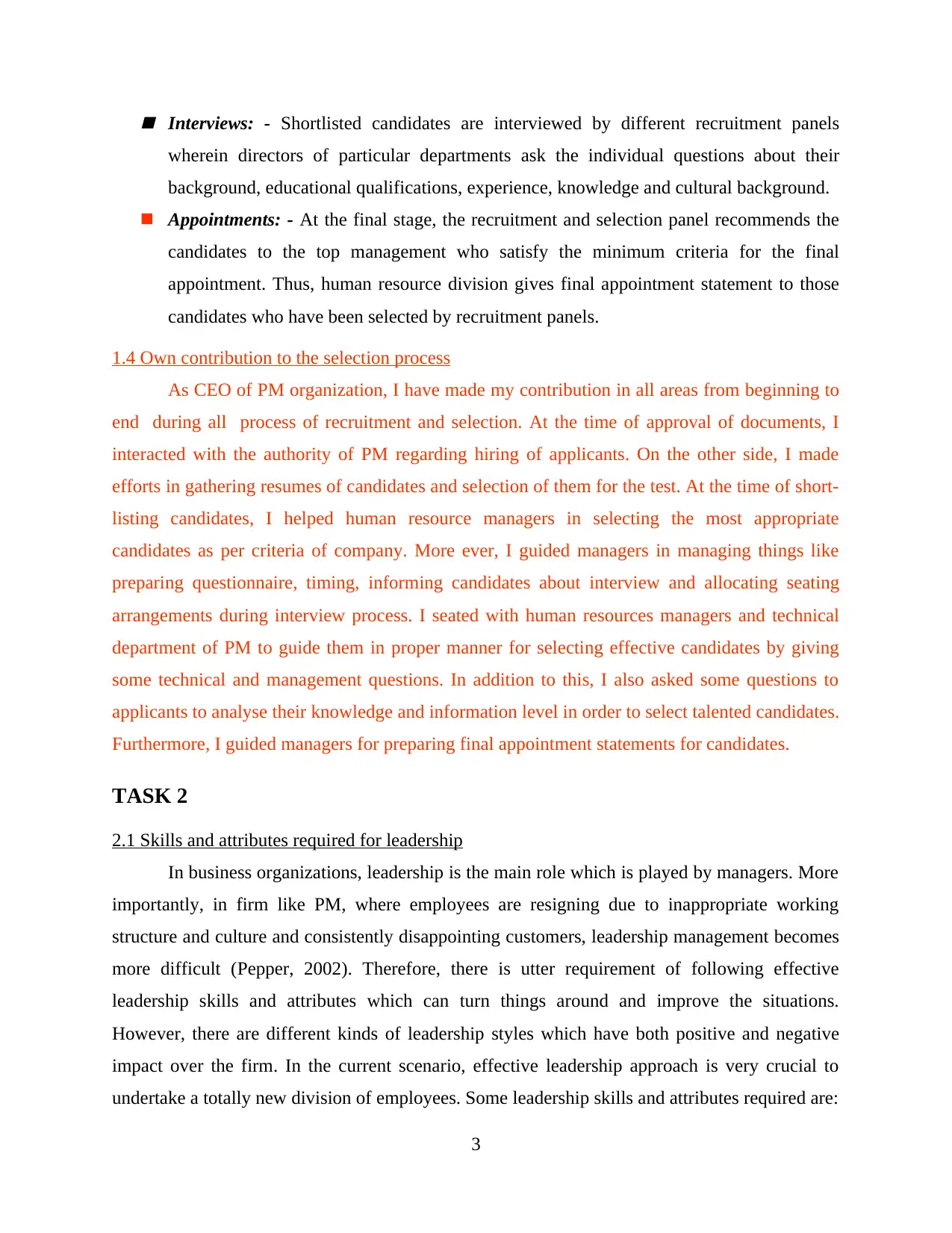
Interviews: - Shortlisted candidates are interviewed by different recruitment panels
wherein directors of particular departments ask the individual questions about their
background, educational qualifications, experience, knowledge and cultural background.
Appointments: - At the final stage, the recruitment and selection panel recommends the
candidates to the top management who satisfy the minimum criteria for the final
appointment. Thus, human resource division gives final appointment statement to those
candidates who have been selected by recruitment panels.
1.4 Own contribution to the selection process
As CEO of PM organization, I have made my contribution in all areas from beginning to
end during all process of recruitment and selection. At the time of approval of documents, I
interacted with the authority of PM regarding hiring of applicants. On the other side, I made
efforts in gathering resumes of candidates and selection of them for the test. At the time of short-
listing candidates, I helped human resource managers in selecting the most appropriate
candidates as per criteria of company. More ever, I guided managers in managing things like
preparing questionnaire, timing, informing candidates about interview and allocating seating
arrangements during interview process. I seated with human resources managers and technical
department of PM to guide them in proper manner for selecting effective candidates by giving
some technical and management questions. In addition to this, I also asked some questions to
applicants to analyse their knowledge and information level in order to select talented candidates.
Furthermore, I guided managers for preparing final appointment statements for candidates.
TASK 2
2.1 Skills and attributes required for leadership
In business organizations, leadership is the main role which is played by managers. More
importantly, in firm like PM, where employees are resigning due to inappropriate working
structure and culture and consistently disappointing customers, leadership management becomes
more difficult (Pepper, 2002). Therefore, there is utter requirement of following effective
leadership skills and attributes which can turn things around and improve the situations.
However, there are different kinds of leadership styles which have both positive and negative
impact over the firm. In the current scenario, effective leadership approach is very crucial to
undertake a totally new division of employees. Some leadership skills and attributes required are:
3
wherein directors of particular departments ask the individual questions about their
background, educational qualifications, experience, knowledge and cultural background.
Appointments: - At the final stage, the recruitment and selection panel recommends the
candidates to the top management who satisfy the minimum criteria for the final
appointment. Thus, human resource division gives final appointment statement to those
candidates who have been selected by recruitment panels.
1.4 Own contribution to the selection process
As CEO of PM organization, I have made my contribution in all areas from beginning to
end during all process of recruitment and selection. At the time of approval of documents, I
interacted with the authority of PM regarding hiring of applicants. On the other side, I made
efforts in gathering resumes of candidates and selection of them for the test. At the time of short-
listing candidates, I helped human resource managers in selecting the most appropriate
candidates as per criteria of company. More ever, I guided managers in managing things like
preparing questionnaire, timing, informing candidates about interview and allocating seating
arrangements during interview process. I seated with human resources managers and technical
department of PM to guide them in proper manner for selecting effective candidates by giving
some technical and management questions. In addition to this, I also asked some questions to
applicants to analyse their knowledge and information level in order to select talented candidates.
Furthermore, I guided managers for preparing final appointment statements for candidates.
TASK 2
2.1 Skills and attributes required for leadership
In business organizations, leadership is the main role which is played by managers. More
importantly, in firm like PM, where employees are resigning due to inappropriate working
structure and culture and consistently disappointing customers, leadership management becomes
more difficult (Pepper, 2002). Therefore, there is utter requirement of following effective
leadership skills and attributes which can turn things around and improve the situations.
However, there are different kinds of leadership styles which have both positive and negative
impact over the firm. In the current scenario, effective leadership approach is very crucial to
undertake a totally new division of employees. Some leadership skills and attributes required are:
3
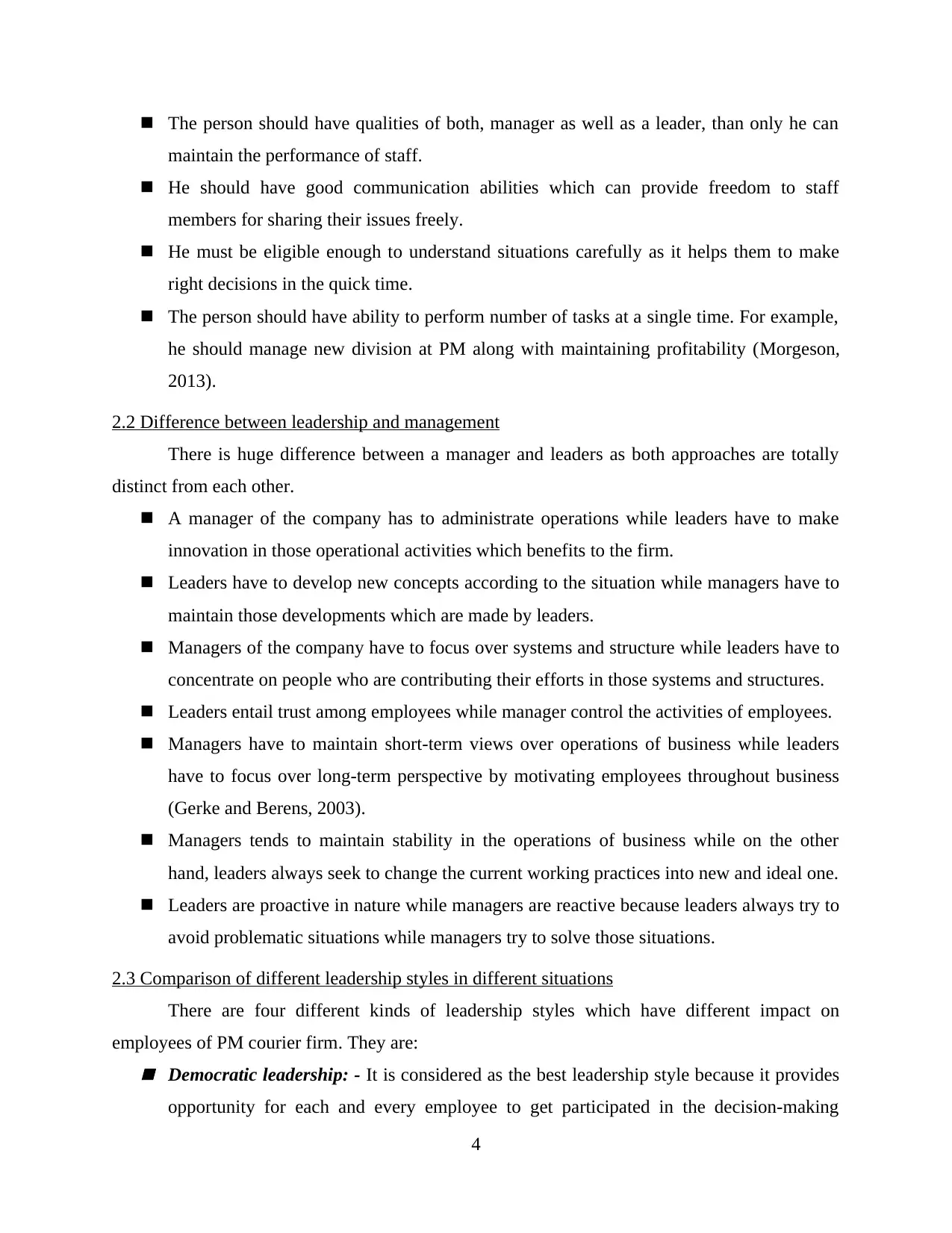
The person should have qualities of both, manager as well as a leader, than only he can
maintain the performance of staff.
He should have good communication abilities which can provide freedom to staff
members for sharing their issues freely.
He must be eligible enough to understand situations carefully as it helps them to make
right decisions in the quick time.
The person should have ability to perform number of tasks at a single time. For example,
he should manage new division at PM along with maintaining profitability (Morgeson,
2013).
2.2 Difference between leadership and management
There is huge difference between a manager and leaders as both approaches are totally
distinct from each other.
A manager of the company has to administrate operations while leaders have to make
innovation in those operational activities which benefits to the firm.
Leaders have to develop new concepts according to the situation while managers have to
maintain those developments which are made by leaders.
Managers of the company have to focus over systems and structure while leaders have to
concentrate on people who are contributing their efforts in those systems and structures.
Leaders entail trust among employees while manager control the activities of employees.
Managers have to maintain short-term views over operations of business while leaders
have to focus over long-term perspective by motivating employees throughout business
(Gerke and Berens, 2003).
Managers tends to maintain stability in the operations of business while on the other
hand, leaders always seek to change the current working practices into new and ideal one.
Leaders are proactive in nature while managers are reactive because leaders always try to
avoid problematic situations while managers try to solve those situations.
2.3 Comparison of different leadership styles in different situations
There are four different kinds of leadership styles which have different impact on
employees of PM courier firm. They are: Democratic leadership: - It is considered as the best leadership style because it provides
opportunity for each and every employee to get participated in the decision-making
4
maintain the performance of staff.
He should have good communication abilities which can provide freedom to staff
members for sharing their issues freely.
He must be eligible enough to understand situations carefully as it helps them to make
right decisions in the quick time.
The person should have ability to perform number of tasks at a single time. For example,
he should manage new division at PM along with maintaining profitability (Morgeson,
2013).
2.2 Difference between leadership and management
There is huge difference between a manager and leaders as both approaches are totally
distinct from each other.
A manager of the company has to administrate operations while leaders have to make
innovation in those operational activities which benefits to the firm.
Leaders have to develop new concepts according to the situation while managers have to
maintain those developments which are made by leaders.
Managers of the company have to focus over systems and structure while leaders have to
concentrate on people who are contributing their efforts in those systems and structures.
Leaders entail trust among employees while manager control the activities of employees.
Managers have to maintain short-term views over operations of business while leaders
have to focus over long-term perspective by motivating employees throughout business
(Gerke and Berens, 2003).
Managers tends to maintain stability in the operations of business while on the other
hand, leaders always seek to change the current working practices into new and ideal one.
Leaders are proactive in nature while managers are reactive because leaders always try to
avoid problematic situations while managers try to solve those situations.
2.3 Comparison of different leadership styles in different situations
There are four different kinds of leadership styles which have different impact on
employees of PM courier firm. They are: Democratic leadership: - It is considered as the best leadership style because it provides
opportunity for each and every employee to get participated in the decision-making
4
⊘ This is a preview!⊘
Do you want full access?
Subscribe today to unlock all pages.

Trusted by 1+ million students worldwide
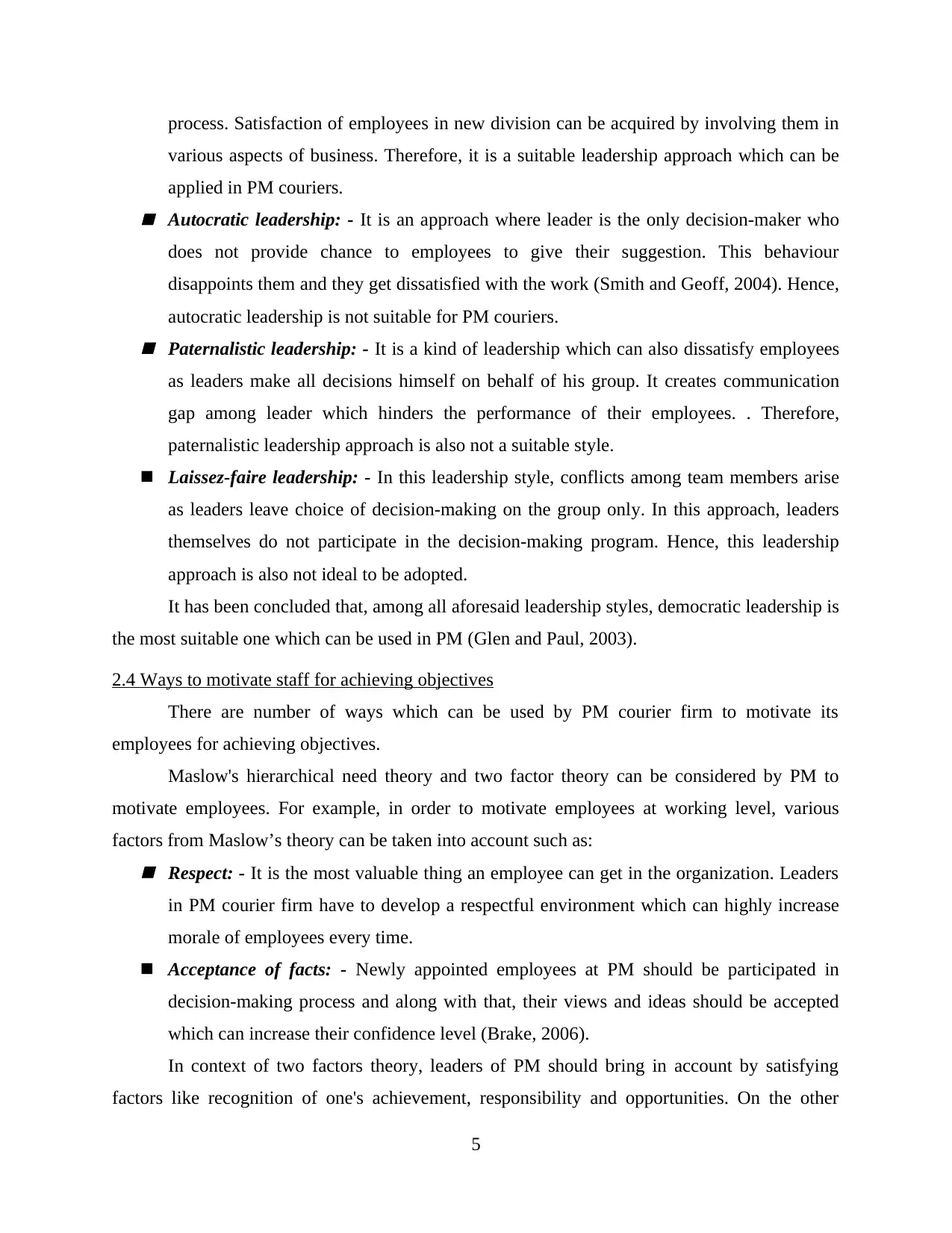
process. Satisfaction of employees in new division can be acquired by involving them in
various aspects of business. Therefore, it is a suitable leadership approach which can be
applied in PM couriers. Autocratic leadership: - It is an approach where leader is the only decision-maker who
does not provide chance to employees to give their suggestion. This behaviour
disappoints them and they get dissatisfied with the work (Smith and Geoff, 2004). Hence,
autocratic leadership is not suitable for PM couriers. Paternalistic leadership: - It is a kind of leadership which can also dissatisfy employees
as leaders make all decisions himself on behalf of his group. It creates communication
gap among leader which hinders the performance of their employees. . Therefore,
paternalistic leadership approach is also not a suitable style.
Laissez-faire leadership: - In this leadership style, conflicts among team members arise
as leaders leave choice of decision-making on the group only. In this approach, leaders
themselves do not participate in the decision-making program. Hence, this leadership
approach is also not ideal to be adopted.
It has been concluded that, among all aforesaid leadership styles, democratic leadership is
the most suitable one which can be used in PM (Glen and Paul, 2003).
2.4 Ways to motivate staff for achieving objectives
There are number of ways which can be used by PM courier firm to motivate its
employees for achieving objectives.
Maslow's hierarchical need theory and two factor theory can be considered by PM to
motivate employees. For example, in order to motivate employees at working level, various
factors from Maslow’s theory can be taken into account such as: Respect: - It is the most valuable thing an employee can get in the organization. Leaders
in PM courier firm have to develop a respectful environment which can highly increase
morale of employees every time.
Acceptance of facts: - Newly appointed employees at PM should be participated in
decision-making process and along with that, their views and ideas should be accepted
which can increase their confidence level (Brake, 2006).
In context of two factors theory, leaders of PM should bring in account by satisfying
factors like recognition of one's achievement, responsibility and opportunities. On the other
5
various aspects of business. Therefore, it is a suitable leadership approach which can be
applied in PM couriers. Autocratic leadership: - It is an approach where leader is the only decision-maker who
does not provide chance to employees to give their suggestion. This behaviour
disappoints them and they get dissatisfied with the work (Smith and Geoff, 2004). Hence,
autocratic leadership is not suitable for PM couriers. Paternalistic leadership: - It is a kind of leadership which can also dissatisfy employees
as leaders make all decisions himself on behalf of his group. It creates communication
gap among leader which hinders the performance of their employees. . Therefore,
paternalistic leadership approach is also not a suitable style.
Laissez-faire leadership: - In this leadership style, conflicts among team members arise
as leaders leave choice of decision-making on the group only. In this approach, leaders
themselves do not participate in the decision-making program. Hence, this leadership
approach is also not ideal to be adopted.
It has been concluded that, among all aforesaid leadership styles, democratic leadership is
the most suitable one which can be used in PM (Glen and Paul, 2003).
2.4 Ways to motivate staff for achieving objectives
There are number of ways which can be used by PM courier firm to motivate its
employees for achieving objectives.
Maslow's hierarchical need theory and two factor theory can be considered by PM to
motivate employees. For example, in order to motivate employees at working level, various
factors from Maslow’s theory can be taken into account such as: Respect: - It is the most valuable thing an employee can get in the organization. Leaders
in PM courier firm have to develop a respectful environment which can highly increase
morale of employees every time.
Acceptance of facts: - Newly appointed employees at PM should be participated in
decision-making process and along with that, their views and ideas should be accepted
which can increase their confidence level (Brake, 2006).
In context of two factors theory, leaders of PM should bring in account by satisfying
factors like recognition of one's achievement, responsibility and opportunities. On the other
5
Paraphrase This Document
Need a fresh take? Get an instant paraphrase of this document with our AI Paraphraser

hand, they should try to avoid hygiene factors like job security, salary, fringe benefits, working
conditions etc.
Therefore, it has been ascertained that, Maslow's need hierarchy and Two-factor theory
are the two most effective ways or models that can be used by leaders at PM couriers for
motivating employees.
TASK 3
3.1 Assessment of benefits of team working in PM
Team work is considered as the most effective factor for development of every business
organization. Sharing of skills and knowledge from one employee to another is the major benefit
of team work. There are number of benefits which PM courier firm can get through effective
team work, they are: Higher quality outcomes: - Customer who was got dissatisfied with slow service of PM
can observe improvement in quality of service (Wheeler and Edlebeck, 2006). Employees
in a unit can perform much better than working individually. Builds trust: - Team work builds trust among one another in an organization. Newly
appointed employees can assist each other during work and solve queries regarding
delivering couriers. Employee relations: - Effective team work can aid PM in developing relationship among
employees which is a positive sign of improvement. Through improvised relationship of
employees, customers can also get benefited in terms of reliable and quick services.
Reduces stress: -The main advantage of team work of PM couriers is that it can reduce
stress among employees. Sharing tasks of each other reduces complexity within the
workplace and results in growth of business (Dias, 2015).
3.2 Demonstration of working in a team as a team leader
In the cited firm there are number of issues which are faced by leaders on daily basis and
that should be resolved as quickly as possible for maintaining smooth flow of operations.
However, roles that can be played by team leaders in the mentioned firm can be explained
through Belbin's team role model. It includes different roles played by leaders in different types
of situations. They are:
6
conditions etc.
Therefore, it has been ascertained that, Maslow's need hierarchy and Two-factor theory
are the two most effective ways or models that can be used by leaders at PM couriers for
motivating employees.
TASK 3
3.1 Assessment of benefits of team working in PM
Team work is considered as the most effective factor for development of every business
organization. Sharing of skills and knowledge from one employee to another is the major benefit
of team work. There are number of benefits which PM courier firm can get through effective
team work, they are: Higher quality outcomes: - Customer who was got dissatisfied with slow service of PM
can observe improvement in quality of service (Wheeler and Edlebeck, 2006). Employees
in a unit can perform much better than working individually. Builds trust: - Team work builds trust among one another in an organization. Newly
appointed employees can assist each other during work and solve queries regarding
delivering couriers. Employee relations: - Effective team work can aid PM in developing relationship among
employees which is a positive sign of improvement. Through improvised relationship of
employees, customers can also get benefited in terms of reliable and quick services.
Reduces stress: -The main advantage of team work of PM couriers is that it can reduce
stress among employees. Sharing tasks of each other reduces complexity within the
workplace and results in growth of business (Dias, 2015).
3.2 Demonstration of working in a team as a team leader
In the cited firm there are number of issues which are faced by leaders on daily basis and
that should be resolved as quickly as possible for maintaining smooth flow of operations.
However, roles that can be played by team leaders in the mentioned firm can be explained
through Belbin's team role model. It includes different roles played by leaders in different types
of situations. They are:
6
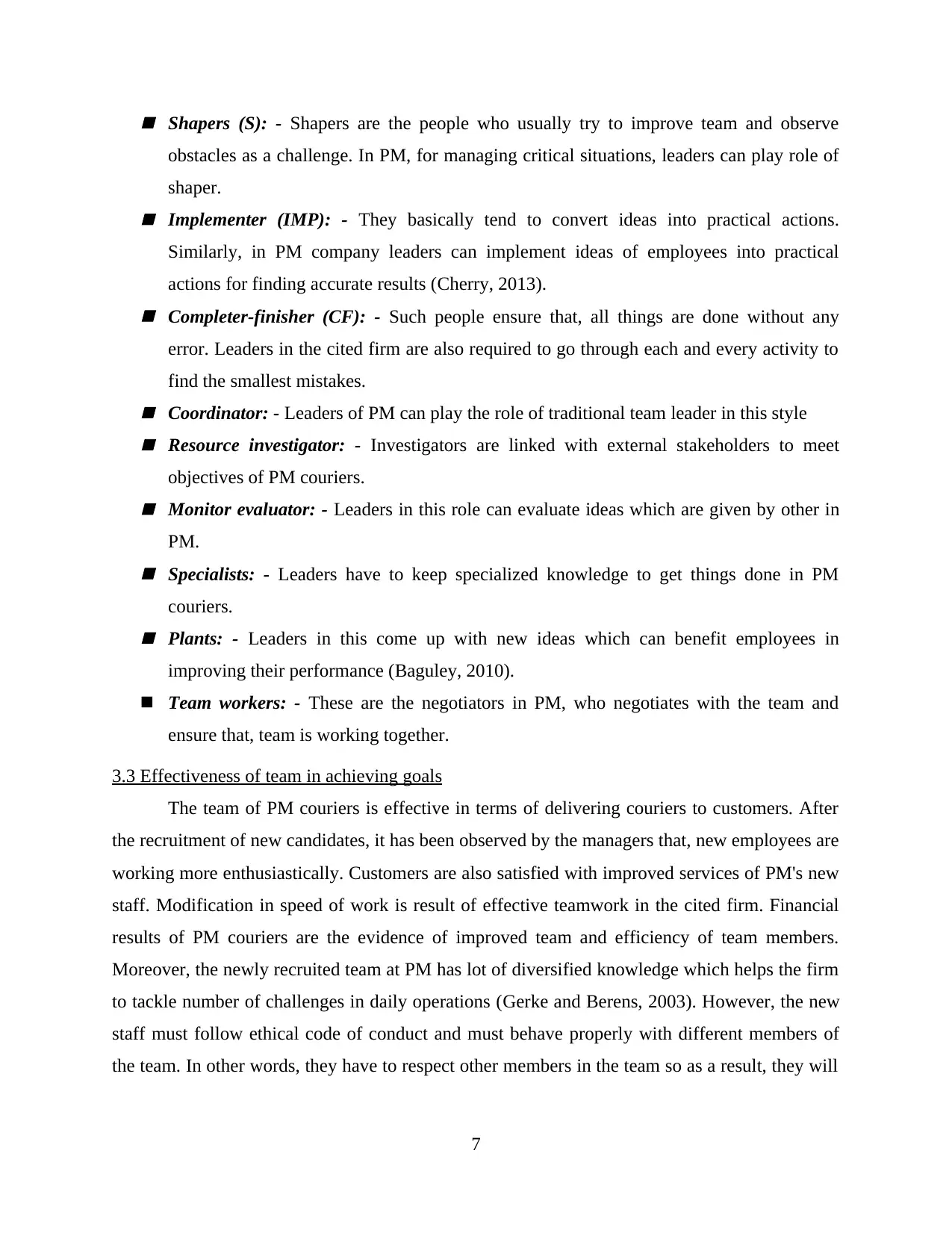
Shapers (S): - Shapers are the people who usually try to improve team and observe
obstacles as a challenge. In PM, for managing critical situations, leaders can play role of
shaper. Implementer (IMP): - They basically tend to convert ideas into practical actions.
Similarly, in PM company leaders can implement ideas of employees into practical
actions for finding accurate results (Cherry, 2013). Completer-finisher (CF): - Such people ensure that, all things are done without any
error. Leaders in the cited firm are also required to go through each and every activity to
find the smallest mistakes. Coordinator: - Leaders of PM can play the role of traditional team leader in this style Resource investigator: - Investigators are linked with external stakeholders to meet
objectives of PM couriers. Monitor evaluator: - Leaders in this role can evaluate ideas which are given by other in
PM. Specialists: - Leaders have to keep specialized knowledge to get things done in PM
couriers. Plants: - Leaders in this come up with new ideas which can benefit employees in
improving their performance (Baguley, 2010).
Team workers: - These are the negotiators in PM, who negotiates with the team and
ensure that, team is working together.
3.3 Effectiveness of team in achieving goals
The team of PM couriers is effective in terms of delivering couriers to customers. After
the recruitment of new candidates, it has been observed by the managers that, new employees are
working more enthusiastically. Customers are also satisfied with improved services of PM's new
staff. Modification in speed of work is result of effective teamwork in the cited firm. Financial
results of PM couriers are the evidence of improved team and efficiency of team members.
Moreover, the newly recruited team at PM has lot of diversified knowledge which helps the firm
to tackle number of challenges in daily operations (Gerke and Berens, 2003). However, the new
staff must follow ethical code of conduct and must behave properly with different members of
the team. In other words, they have to respect other members in the team so as a result, they will
7
obstacles as a challenge. In PM, for managing critical situations, leaders can play role of
shaper. Implementer (IMP): - They basically tend to convert ideas into practical actions.
Similarly, in PM company leaders can implement ideas of employees into practical
actions for finding accurate results (Cherry, 2013). Completer-finisher (CF): - Such people ensure that, all things are done without any
error. Leaders in the cited firm are also required to go through each and every activity to
find the smallest mistakes. Coordinator: - Leaders of PM can play the role of traditional team leader in this style Resource investigator: - Investigators are linked with external stakeholders to meet
objectives of PM couriers. Monitor evaluator: - Leaders in this role can evaluate ideas which are given by other in
PM. Specialists: - Leaders have to keep specialized knowledge to get things done in PM
couriers. Plants: - Leaders in this come up with new ideas which can benefit employees in
improving their performance (Baguley, 2010).
Team workers: - These are the negotiators in PM, who negotiates with the team and
ensure that, team is working together.
3.3 Effectiveness of team in achieving goals
The team of PM couriers is effective in terms of delivering couriers to customers. After
the recruitment of new candidates, it has been observed by the managers that, new employees are
working more enthusiastically. Customers are also satisfied with improved services of PM's new
staff. Modification in speed of work is result of effective teamwork in the cited firm. Financial
results of PM couriers are the evidence of improved team and efficiency of team members.
Moreover, the newly recruited team at PM has lot of diversified knowledge which helps the firm
to tackle number of challenges in daily operations (Gerke and Berens, 2003). However, the new
staff must follow ethical code of conduct and must behave properly with different members of
the team. In other words, they have to respect other members in the team so as a result, they will
7
⊘ This is a preview!⊘
Do you want full access?
Subscribe today to unlock all pages.

Trusted by 1+ million students worldwide
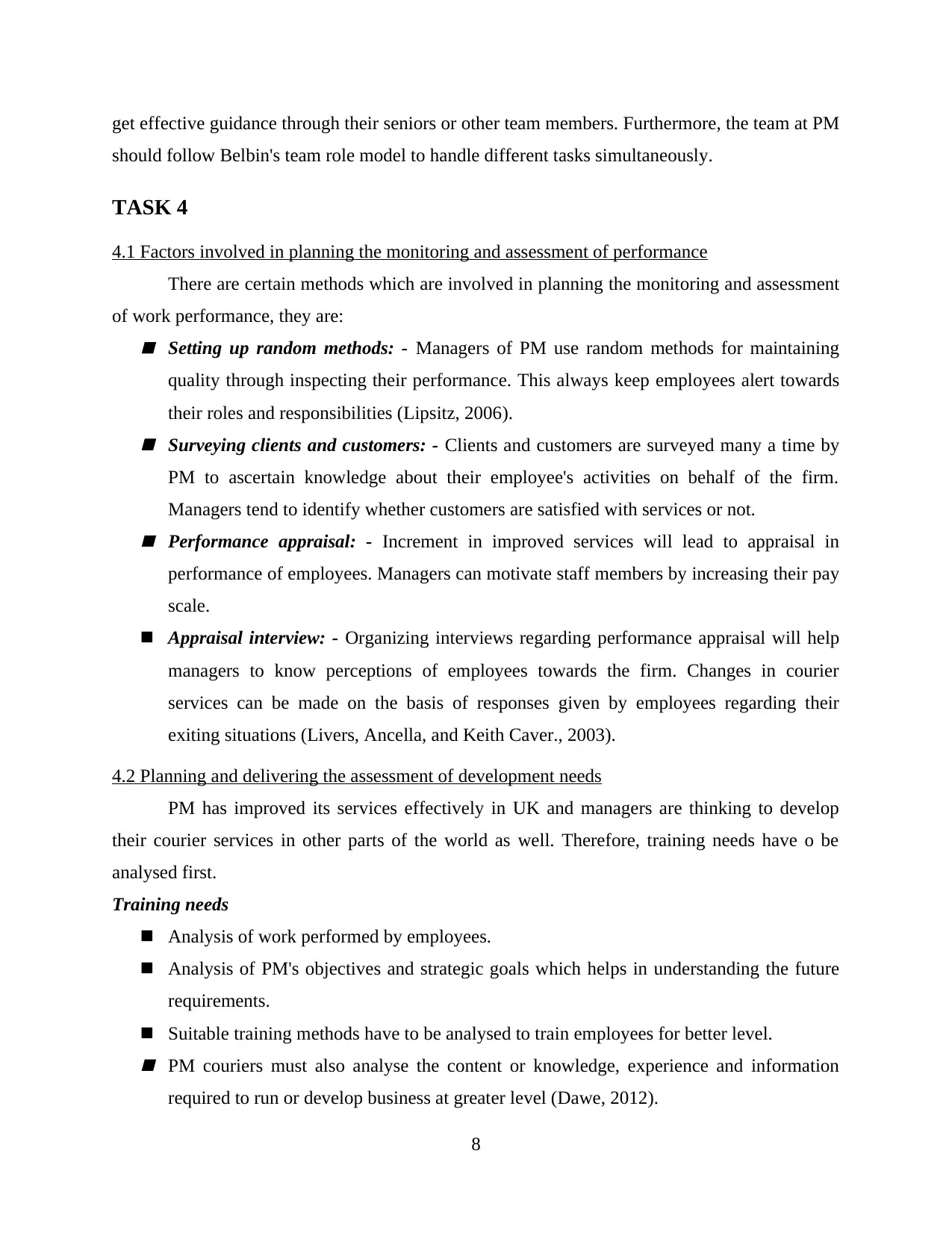
get effective guidance through their seniors or other team members. Furthermore, the team at PM
should follow Belbin's team role model to handle different tasks simultaneously.
TASK 4
4.1 Factors involved in planning the monitoring and assessment of performance
There are certain methods which are involved in planning the monitoring and assessment
of work performance, they are: Setting up random methods: - Managers of PM use random methods for maintaining
quality through inspecting their performance. This always keep employees alert towards
their roles and responsibilities (Lipsitz, 2006). Surveying clients and customers: - Clients and customers are surveyed many a time by
PM to ascertain knowledge about their employee's activities on behalf of the firm.
Managers tend to identify whether customers are satisfied with services or not. Performance appraisal: - Increment in improved services will lead to appraisal in
performance of employees. Managers can motivate staff members by increasing their pay
scale.
Appraisal interview: - Organizing interviews regarding performance appraisal will help
managers to know perceptions of employees towards the firm. Changes in courier
services can be made on the basis of responses given by employees regarding their
exiting situations (Livers, Ancella, and Keith Caver., 2003).
4.2 Planning and delivering the assessment of development needs
PM has improved its services effectively in UK and managers are thinking to develop
their courier services in other parts of the world as well. Therefore, training needs have o be
analysed first.
Training needs
Analysis of work performed by employees.
Analysis of PM's objectives and strategic goals which helps in understanding the future
requirements.
Suitable training methods have to be analysed to train employees for better level. PM couriers must also analyse the content or knowledge, experience and information
required to run or develop business at greater level (Dawe, 2012).
8
should follow Belbin's team role model to handle different tasks simultaneously.
TASK 4
4.1 Factors involved in planning the monitoring and assessment of performance
There are certain methods which are involved in planning the monitoring and assessment
of work performance, they are: Setting up random methods: - Managers of PM use random methods for maintaining
quality through inspecting their performance. This always keep employees alert towards
their roles and responsibilities (Lipsitz, 2006). Surveying clients and customers: - Clients and customers are surveyed many a time by
PM to ascertain knowledge about their employee's activities on behalf of the firm.
Managers tend to identify whether customers are satisfied with services or not. Performance appraisal: - Increment in improved services will lead to appraisal in
performance of employees. Managers can motivate staff members by increasing their pay
scale.
Appraisal interview: - Organizing interviews regarding performance appraisal will help
managers to know perceptions of employees towards the firm. Changes in courier
services can be made on the basis of responses given by employees regarding their
exiting situations (Livers, Ancella, and Keith Caver., 2003).
4.2 Planning and delivering the assessment of development needs
PM has improved its services effectively in UK and managers are thinking to develop
their courier services in other parts of the world as well. Therefore, training needs have o be
analysed first.
Training needs
Analysis of work performed by employees.
Analysis of PM's objectives and strategic goals which helps in understanding the future
requirements.
Suitable training methods have to be analysed to train employees for better level. PM couriers must also analyse the content or knowledge, experience and information
required to run or develop business at greater level (Dawe, 2012).
8
Paraphrase This Document
Need a fresh take? Get an instant paraphrase of this document with our AI Paraphraser
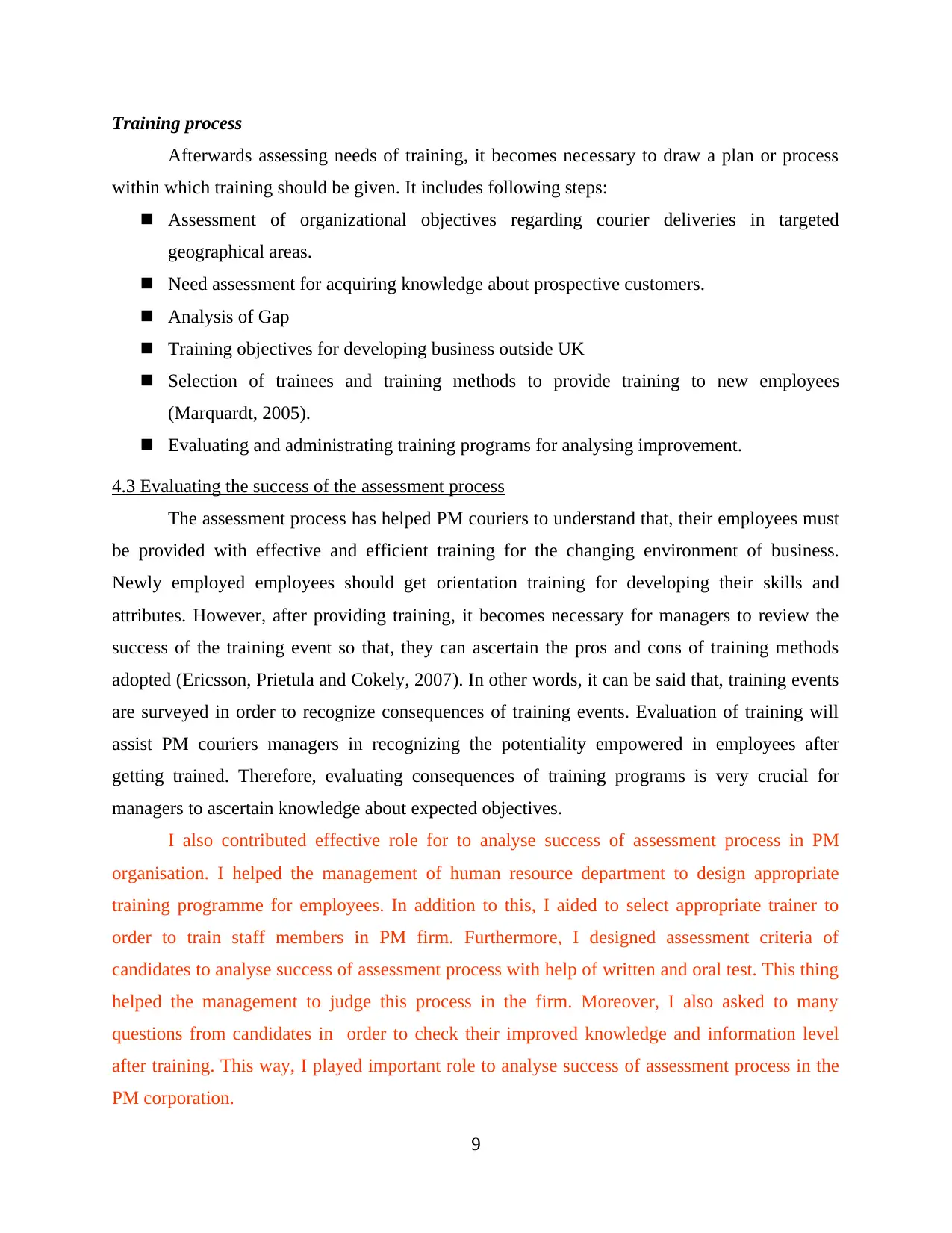
Training process
Afterwards assessing needs of training, it becomes necessary to draw a plan or process
within which training should be given. It includes following steps:
Assessment of organizational objectives regarding courier deliveries in targeted
geographical areas.
Need assessment for acquiring knowledge about prospective customers.
Analysis of Gap
Training objectives for developing business outside UK
Selection of trainees and training methods to provide training to new employees
(Marquardt, 2005).
Evaluating and administrating training programs for analysing improvement.
4.3 Evaluating the success of the assessment process
The assessment process has helped PM couriers to understand that, their employees must
be provided with effective and efficient training for the changing environment of business.
Newly employed employees should get orientation training for developing their skills and
attributes. However, after providing training, it becomes necessary for managers to review the
success of the training event so that, they can ascertain the pros and cons of training methods
adopted (Ericsson, Prietula and Cokely, 2007). In other words, it can be said that, training events
are surveyed in order to recognize consequences of training events. Evaluation of training will
assist PM couriers managers in recognizing the potentiality empowered in employees after
getting trained. Therefore, evaluating consequences of training programs is very crucial for
managers to ascertain knowledge about expected objectives.
I also contributed effective role for to analyse success of assessment process in PM
organisation. I helped the management of human resource department to design appropriate
training programme for employees. In addition to this, I aided to select appropriate trainer to
order to train staff members in PM firm. Furthermore, I designed assessment criteria of
candidates to analyse success of assessment process with help of written and oral test. This thing
helped the management to judge this process in the firm. Moreover, I also asked to many
questions from candidates in order to check their improved knowledge and information level
after training. This way, I played important role to analyse success of assessment process in the
PM corporation.
9
Afterwards assessing needs of training, it becomes necessary to draw a plan or process
within which training should be given. It includes following steps:
Assessment of organizational objectives regarding courier deliveries in targeted
geographical areas.
Need assessment for acquiring knowledge about prospective customers.
Analysis of Gap
Training objectives for developing business outside UK
Selection of trainees and training methods to provide training to new employees
(Marquardt, 2005).
Evaluating and administrating training programs for analysing improvement.
4.3 Evaluating the success of the assessment process
The assessment process has helped PM couriers to understand that, their employees must
be provided with effective and efficient training for the changing environment of business.
Newly employed employees should get orientation training for developing their skills and
attributes. However, after providing training, it becomes necessary for managers to review the
success of the training event so that, they can ascertain the pros and cons of training methods
adopted (Ericsson, Prietula and Cokely, 2007). In other words, it can be said that, training events
are surveyed in order to recognize consequences of training events. Evaluation of training will
assist PM couriers managers in recognizing the potentiality empowered in employees after
getting trained. Therefore, evaluating consequences of training programs is very crucial for
managers to ascertain knowledge about expected objectives.
I also contributed effective role for to analyse success of assessment process in PM
organisation. I helped the management of human resource department to design appropriate
training programme for employees. In addition to this, I aided to select appropriate trainer to
order to train staff members in PM firm. Furthermore, I designed assessment criteria of
candidates to analyse success of assessment process with help of written and oral test. This thing
helped the management to judge this process in the firm. Moreover, I also asked to many
questions from candidates in order to check their improved knowledge and information level
after training. This way, I played important role to analyse success of assessment process in the
PM corporation.
9
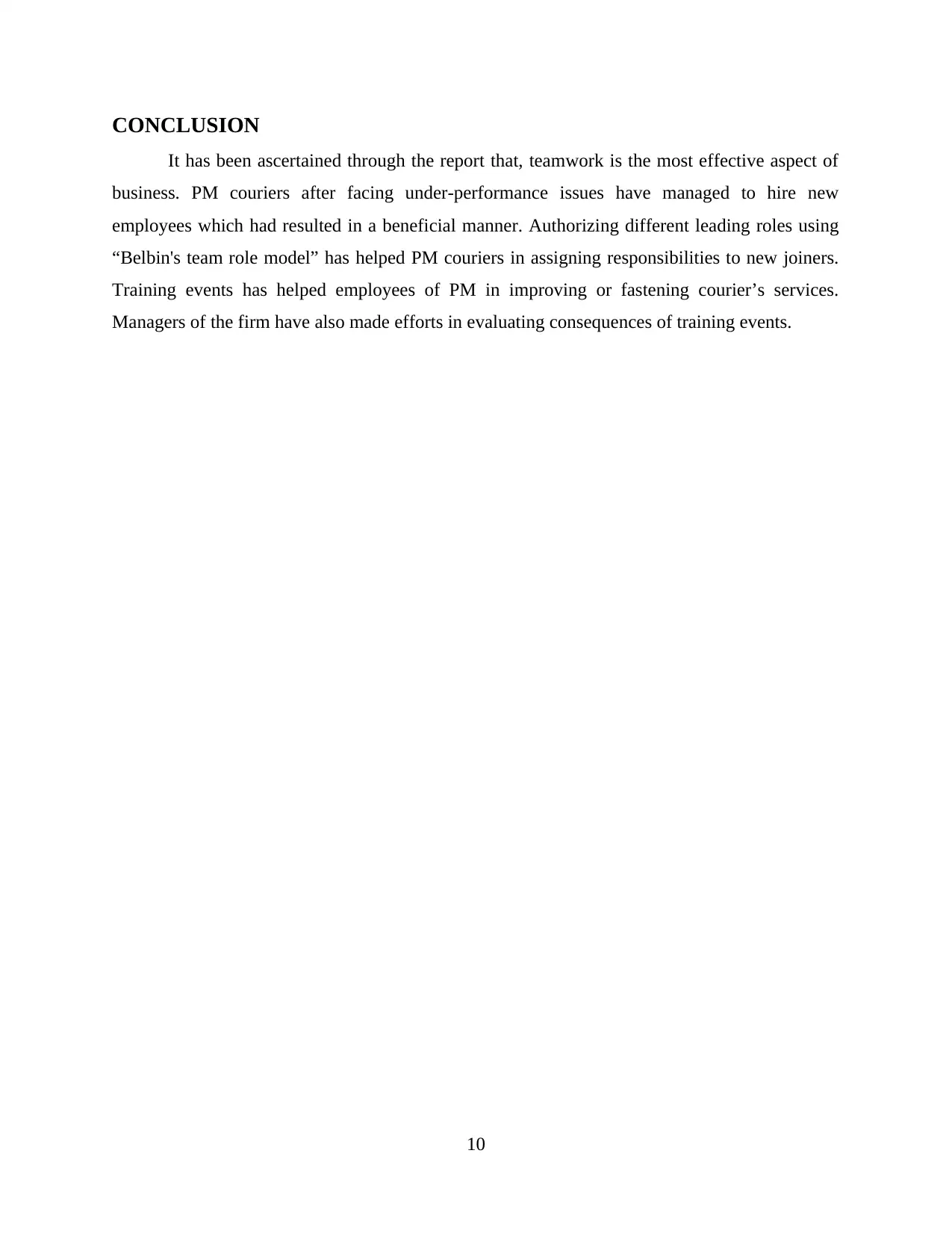
CONCLUSION
It has been ascertained through the report that, teamwork is the most effective aspect of
business. PM couriers after facing under-performance issues have managed to hire new
employees which had resulted in a beneficial manner. Authorizing different leading roles using
“Belbin's team role model” has helped PM couriers in assigning responsibilities to new joiners.
Training events has helped employees of PM in improving or fastening courier’s services.
Managers of the firm have also made efforts in evaluating consequences of training events.
10
It has been ascertained through the report that, teamwork is the most effective aspect of
business. PM couriers after facing under-performance issues have managed to hire new
employees which had resulted in a beneficial manner. Authorizing different leading roles using
“Belbin's team role model” has helped PM couriers in assigning responsibilities to new joiners.
Training events has helped employees of PM in improving or fastening courier’s services.
Managers of the firm have also made efforts in evaluating consequences of training events.
10
⊘ This is a preview!⊘
Do you want full access?
Subscribe today to unlock all pages.

Trusted by 1+ million students worldwide
1 out of 14
Related Documents
Your All-in-One AI-Powered Toolkit for Academic Success.
+13062052269
info@desklib.com
Available 24*7 on WhatsApp / Email
![[object Object]](/_next/static/media/star-bottom.7253800d.svg)
Unlock your academic potential
Copyright © 2020–2025 A2Z Services. All Rights Reserved. Developed and managed by ZUCOL.





